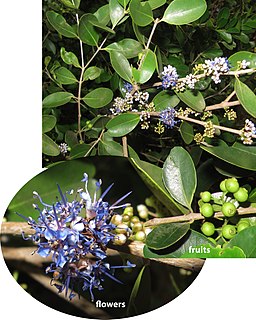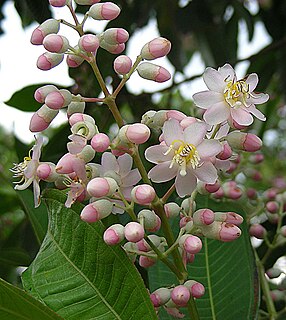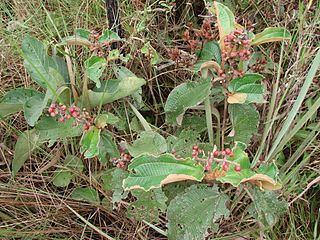
Melastomataceae is a family of dicotyledonous flowering plants found mostly in the tropics comprising c. 165 genera and c. 5115 known species. Melastomes are annual or perennial herbs, shrubs, or small trees.
Graffenrieda caudata is a species of plant in the family Melastomataceae. It is endemic to Guyana.
Graffenrieda bella is a species of plant in the family Melastomataceae. It is endemic to Panama. It is threatened by habitat loss.
Graffenrieda grandifolia is a species of plant in the family Melastomataceae. It is endemic to Colombia.
Graffenrieda harlingii is a species of plant in the family Melastomataceae. It is endemic to Ecuador. Its natural habitats are subtropical or tropical moist montane forests and subtropical or tropical high-altitude shrubland.
Graffenrieda phoenica is a species of plant in the family Melastomataceae. It is endemic to Ecuador. Its natural habitat is subtropical or tropical moist montane forests.
Graffenrieda robusta is a species of plant in the family Melastomataceae. It is endemic to Peru.
Graffenrieda trichanthera is a species of plant in the family Melastomataceae. It is endemic to Peru.

Memecylon is a plant group in Melastomataceae. It consists of 350-400 species of small to medium-sized trees and shrubs occurring in the Old World tropics. Memecylon is a monophyletic group basal to the Melastomataceae clade. Memecylon taxa have more than 600 published basionyms. Diversity of this group is concentrated in tropical Africa, Madagascar, Sri Lanka, India and Malaysia.

Meriania is a genus of flowering plants in the family Melastomataceae. There are about 93 species distributed from Mexico to Brazil and the Antilles.

Pieter B. Pelser is a Lecturer in Plant Systematics and the curator of the herbarium at the University of Canterbury in Christchurch, New Zealand. One research interest is the evolutionary history of the tribe Senecioneae, one of the largest tribes in the largest family of flowering plants. He wrote the most recent attempt to define and delimit this tribe and its problematic founding species Senecio. He also studies insects that eat these plants (Longitarsus) which contain pyrrolizidine alkaloids and what makes them choose which plants they eat.

Bertolonia is a genus consisting of 14 species of pretty, dwarf, creeping, tender perennials, native to tropical South America. These herbaceous plants are grown for their colorful, velvety, ornamental foliages, vary from shimmery white with purple, pink with purple, or bronze-green with carmine and lighter midribs, purple beneath. Leaves are coarsely hairy, oval 7 cm (3 in) long on short stalks. The plants bear clusters of small, bell-shaped flowers repeatedly, just above the leaves, color ranges from pink, red, yellow to purple.

Miconia albicans is a species of shrub in the family Melastomataceae. It is known as "canela de velho" in Brazilian Portuguese. It is native to North and South America.

Miconia fallax is a species of shrub in the family Melastomataceae. It is native to South America.

Miconia lacera is a species of shrub in the family Melastomataceae. It is native to North and South America.

Miconia theaezans is a species of shrub or tree in the family Melastomataceae. It is native to South America.

Miconia ciliata is a species of shrub in the family Melastomataceae. It is native to North and South America.

Miconia macrothyrsa is a species of shrub in the family Melastomataceae. It is native to South America.
Lavoisiera canastrensis is a critically endangered plant species that was found in 2017. It is only known to live in Brazil's Serra da Canastra National Park. This area has been the only known mountaintop in Brazil as the location for the Lavoisiera species. Overall, about 66% are endangered because of limited distributions and small population sizes. To protect the endangered species of Lavoisiera species, a global conservation area, named campo rupestre, is a long-term conservation between governmental and non-governmental agencies to expand, monitor, and support the species.
Melastoma malabituin is a species of shrubs in the plant family Melastomataceae. It is native to the island of Luzon in the Philippines. It was discovered by Filipino botanist John Michael Agcaoilli in 1997 and first described in 2020.





